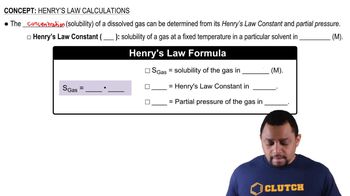Here are the essential concepts you must grasp in order to answer the question correctly.
Henry's Law
Henry's Law states that the amount of gas that dissolves in a liquid at a given temperature is directly proportional to the partial pressure of that gas above the liquid. This relationship can be expressed mathematically as C = kH * P, where C is the concentration of the gas in the liquid, kH is the Henry's law constant, and P is the partial pressure of the gas.
Recommended video:
Solubility
Solubility refers to the maximum amount of a substance that can dissolve in a given volume of solvent at a specific temperature and pressure. In the context of gases, solubility is often expressed in terms of molarity (mol/L), indicating how many moles of gas can be dissolved in one liter of solvent.
Recommended video:
Partial Pressure
Partial pressure is the pressure exerted by a single component of a mixture of gases. In the context of solubility, the partial pressure of a gas above a liquid influences how much of that gas can dissolve in the liquid, as described by Henry's Law. It is typically measured in atmospheres (atm) or other pressure units.
Recommended video:
Partial Pressure Calculation




